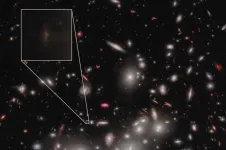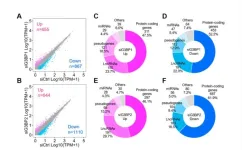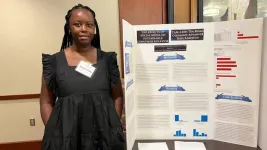(Press-News.org) Key takeaways
After the Big Bang, the universe expanded and cooled sufficiently for hydrogen atoms to form. In the absence of light from the first stars and galaxies, the universe entered a period known as the cosmic dark ages.
The first stars and galaxies appeared several hundred million years later and began burning away the hydrogen fog left over from the Big Bang, rendering the universe transparent, like it is today.
Researchers led by astrophysicists from UCLA confirmed the existence of a distant, faint galaxy typical of those whose light burned through the hydrogen atoms; the finding should help them understand how the cosmic dark ages ended.
An international research team led by UCLA astrophysicists has confirmed the existence of the faintest galaxy ever seen in the early universe. The galaxy, called JD1, is one of the most distant identified to date, and it is typical of the kinds of galaxies that burned through the fog of hydrogen atoms left over from the Big Bang, letting light shine through the universe and shaping it into what exists today.
The discovery was made using NASA’s James Webb Space Telescope, and the findings are published in the journal Nature.
The first billion years of the universe’s life were a crucial period in its evolution. After the Big Bang, approximately 13.8 billion years ago, the universe expanded and cooled sufficiently for hydrogen atoms to form. Hydrogen atoms absorb ultraviolet photons from young stars; however, until the birth of the first stars and galaxies, the universe became dark and entered a period known as the cosmic dark ages. The appearance of the first stars and galaxies a few hundred million years later bathed the universe in energetic ultraviolet light which began burning, or ionizing, the hydrogen fog. That, in turn, enabled photons to travel through space, rendering the universe transparent.
Determining the types of galaxies that dominated that era — dubbed the Epoch of Reionization — is a major goal in astronomy today, but until the development of the Webb telescope, scientists lacked the sensitive infrared instruments required to study the first generation of galaxies.
“Most of the galaxies found with JWST so far are bright galaxies that are rare and not thought to be particularly representative of the young galaxies that populated the early universe,” said Guido Roberts-Borsani, a UCLA postdoctoral researcher and the study’s first author. “As such, while important, they are not thought to be the main agents that burned through all of that hydrogen fog.
“Ultra-faint galaxies such as JD1, on the other hand, are far more numerous, which is why we believe they are more representative of the galaxies that conducted the reionization process, allowing ultraviolet light to travel unimpeded through space and time.”
JD1 is so dim and so far away that it is challenging to study without a powerful telescope — and a helping hand from nature. JD1 is located behind a large cluster of nearby galaxies, called Abell 2744, whose combined gravitational strength bends and amplifies the light from JD1, making it appear larger and 13 times brighter than it otherwise would. The effect, known as gravitational lensing, is similar to how a magnifying glass distorts and amplifies light within its field of view; without gravitational lensing, JD1 would likely have been missed.
The researchers used the Webb Telescope’s near-infrared spectrograph instrument, NIRSpec, to obtain an infrared light spectrum of the galaxy, allowing them to determine its precise age and its distance from Earth, as well as the number of stars and amount of dust and heavy elements that it formed in its relatively short lifetime.
The combination of the galaxy’s gravitational magnification and new images from another one of the Webb Telescope’s near-infrared instruments, NIRCam, also made it possible for the team to study the galaxy’s structure in unprecedented detail and resolution, revealing three main elongated clumps of dust and gas that are forming stars. The team used the new data to trace JD1’s light back to its original source and shape, revealing a compact galaxy just a fraction of the size of older galaxies like the Milky Way, which is 13.6 billion years old.
Because light takes time to travel to Earth, JD1 is seen as it was approximately 13.3 billion years ago, when the universe was only about 4% of its present age.
“Before the Webb telescope switched on, just a year ago, we could not even dream of confirming such a faint galaxy,” said Tommaso Treu, a UCLA physics and astronomy professor, and the study’s second author. “The combination of JWST and the magnifying power of gravitational lensing is a revolution. We are rewriting the book on how galaxies formed and evolved in the immediate aftermath of the Big Bang.”
END
Astrophysicists confirm the faintest galaxy ever seen in the early universe
The small, distant galaxy JD1 is typical of the kind that burned through hydrogen left over from the Big Bang
2023-06-01
ELSE PRESS RELEASES FROM THIS DATE:
Stress granules control Alzheimer's gene transcripts and neuronal proteostasis
2023-06-01
“Determining the mechanism underlying RNA sequestration in [stress granules] [...] could represent a key goal in the discovery and development of suitable [Alzheimer’s disease] biomarkers and therapies.”
BUFFALO, NY- June 1, 2023 – A new research paper was published on the cover of Aging (listed by MEDLINE/PubMed as "Aging (Albany NY)" and "Aging-US" by Web of Science) Volume 15, Issue 10, entitled, “Stress granules sequester Alzheimer’s disease-associated gene transcripts and regulate disease-related neuronal proteostasis.”
Environmental and physiological stresses ...
MU textiles professor earns grant as part of USDA’s Higher Education Challenge
2023-06-01
When you think about big data and fashion, it seems unlikely that the two might be stitched together. However, the modern fashion industry depends on data analytics throughout the supply chain to serve customers in ways that champion innovation, including expanding designers’ creativity, calculating the environmental impact of making a product and keeping brands up to date on changes in the market.
In an inventive project funded by a Department of Agriculture (USDA) grant of $149,000 awarded to Li Zhao, a professor of textiles and apparel management in the University of Missouri’s College of Arts and Science, students will ...
Deep-brain stimulation during sleep strengthens memory
2023-06-01
While it’s known that sleep plays a crucial role in strengthening memory, scientists are still trying to decode how this process plays out in the brain overnight.
New research led by scientists at UCLA Health and Tel Aviv University provides the first physiological evidence from inside the human brain supporting the dominant scientific theory on how the brain consolidates memory during sleep. Further, the researchers found that targeted deep-brain stimulation during a critical time in the sleep cycle appeared to improve memory consolidation.
The research, published June 1 in Nature Neuroscience, ...
School toolkits
2023-06-01
Children and young people naturally spend a large amount of their time at school, college or in other educational settings. Whilst most children with JIA are able to access education, many require adaptations or specific support to enable them to fully engage in learning. But families of children with JIA report lack of awareness and understanding, and believe that schools need special resources to be able to support these children and young people.
In the UK, Juvenile Arthritis Research (JAR) has developed a toolkit to allow teachers and school staff to confidently support children with JIA, and the initial rollout was assessed ...
Long-term risks of targeted therapies
2023-06-01
Janus kinase inhibitors (JAKi) and biologics are the cornerstone of modern treatment for rheumatoid arthritis (RA). But there have been concerns over long-term side effects. New data from a national healthcare database offer reassuring findings for overall cancers and cardiovascular disease (CVD).
Patients with inflammatory rheumatic diseases have an increased risk of CVD compared to the general population.1 In acknowledgement of this, EULAR – the European Alliance of Associations for Rheumatology – has published recommendations for cardiovascular risk management ...
Managing anxiety and depression in arthritis
2023-06-01
Anxiety and depression are the mental health issues most commonly associated with inflammatory arthritis, and it is well-established that there is a link between mental health issues and poor health outcomes.2 The EULAR recommendations emphasize the need to assess mental health regularly;1 however, little is known about the association between self-management and mental health in people with inflammatory arthritis.
At the 2023 EULAR congress, Vestergaard and colleagues report on their cross-sectional study in Denmark. This included 42,407 adult patients with rheumatoid arthritis (RA), psoriatic arthritis (PsA), or spondylarthritis (axSpA). The aim was to find ...
Healthy lifestyle and mortality in osteoarthritis
2023-06-01
In this work, data from the UK Biobank were used to investigate the association of both individual and combined healthy lifestyle factors with the risk of all-cause and cause-specific mortality among 104,142 people with osteoarthritis.
The researchers gave each person a score for their lifestyle, based on their body mass index (BMI) and self-reported diet, sleep duration, physical activity, sedentary time, social connection, smoking, and alcohol drinking – all factors thought to be associated with health.
Overall, there were 9,915 deaths recorded after the first 2 years’ ...
The European Alliance of Associations For Rheumatology, EULAR, announces its strategy for 2024 – 2028
2023-06-01
Over the period 2018 – 2023, EULAR, the leading organisation in RMDs, has grown substantially and has been professionalised in every aspect. For example, EULAR has increased its impact on RMDs through the development of new services provided by the EULAR Research Centre (ERC). Despite the disruption of routine procedures brought about by the pandemic, EULAR overcame the substantial associated challenges, providing continued access to education and networking for the RMD community. “We have made tremendous progress by setting up two virtual congresses and one fully hybrid congress, and we have ...
EULAR launches ‘RheumaFacts’, a unique and Pan-European data repository of rheumatic and musculoskeletal disease indicators
2023-06-01
The European Alliance of Associations for Rheumatology (EULAR) is proud to announce the launch of RheumaFacts, an innovative and unique resource of facts and figures related to rheumatic and musculoskeletal diseases (RMDs) across Europe. Strategically developed to support EULAR’s mission of reducing the impact of RMDs on individuals and society, RheumaFacts will serve as a powerful tool to provide healthcare professionals, researchers, policymakers, and patients with data-driven insights on the status of rheumatologic care across EULAR’s ...
EULAR launches first European patient-filled survey about the impact of rheumatic and musculoskeletal diseases on individual’s lives
2023-06-01
The European Alliance of Associations for Rheumatology (EULAR) has announced the launch of the EULAR Impact of RMDs Survey, an online questionnaire targeted directly at RMD patients. The data collected through this survey will be an important resource for researchers, healthcare professionals, and patients alike, providing a comprehensive database of patient-reported outcomes on their healthcare situation, and how the illness affects their social and occupational lives. By collecting and analysing data from a large number of patients with RMDs on a recurring basis, the survey will provide valuable insights into the burden of disease and help improve the overall care for people living with ...
LAST 30 PRESS RELEASES:
JULAC and Taylor & Francis sign open access agreement to boost the impact of Hong Kong research
Protecting older male athletes’ heart health
KAIST proposes AI-driven strategy to solve long-standing mystery of gene function
Eye for trouble: Automated counting for chromosome issues under the microscope
The vast majority of US rivers lack any protections from human activities, new research finds
Ultrasound-responsive in situ antigen "nanocatchers" open a new paradigm for personalized tumor immunotherapy
Environmental “superbugs” in our rivers and soils: new one health review warns of growing antimicrobial resistance crisis
Triple threat in greenhouse farming: how heavy metals, microplastics, and antibiotic resistance genes unite to challenge sustainable food production
Earthworms turn manure into a powerful tool against antibiotic resistance
AI turns water into an early warning network for hidden biological pollutants
Hidden hotspots on “green” plastics: biodegradable and conventional plastics shape very different antibiotic resistance risks in river microbiomes
Engineered biochar enzyme system clears toxic phenolic acids and restores pepper seed germination in continuous cropping soils
Retail therapy fail? Online shopping linked to stress, says study
How well-meaning allies can increase stress for marginalized people
Commercially viable biomanufacturing: designer yeast turns sugar into lucrative chemical 3-HP
Control valve discovered in gut’s plumbing system
George Mason University leads phase 2 clinical trial for pill to help maintain weight loss after GLP-1s
Hop to it: research from Shedd Aquarium tracks conch movement to set new conservation guidance
Weight loss drugs and bariatric surgery improve the body’s fat ‘balance:’ study
The Age of Fishes began with mass death
TB harnesses part of immune defense system to cause infection
Important new source of oxidation in the atmosphere found
A tug-of-war explains a decades-old question about how bacteria swim
Strengthened immune defense against cancer
Engineering the development of the pancreas
The Journal of Nuclear Medicine ahead-of-print tip sheet: Jan. 9, 2026
Mount Sinai researchers help create largest immune cell atlas of bone marrow in multiple myeloma patients
Why it is so hard to get started on an unpleasant task: Scientists identify a “motivation brake”
Body composition changes after bariatric surgery or treatment with GLP-1 receptor agonists
Targeted regulation of abortion providers laws and pregnancies conceived through fertility treatment
[Press-News.org] Astrophysicists confirm the faintest galaxy ever seen in the early universeThe small, distant galaxy JD1 is typical of the kind that burned through hydrogen left over from the Big Bang


